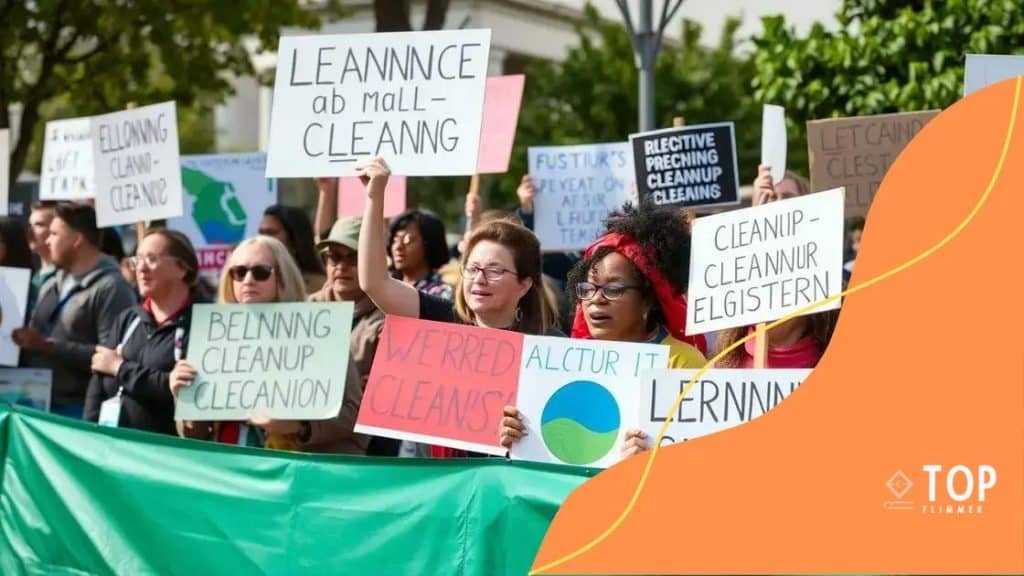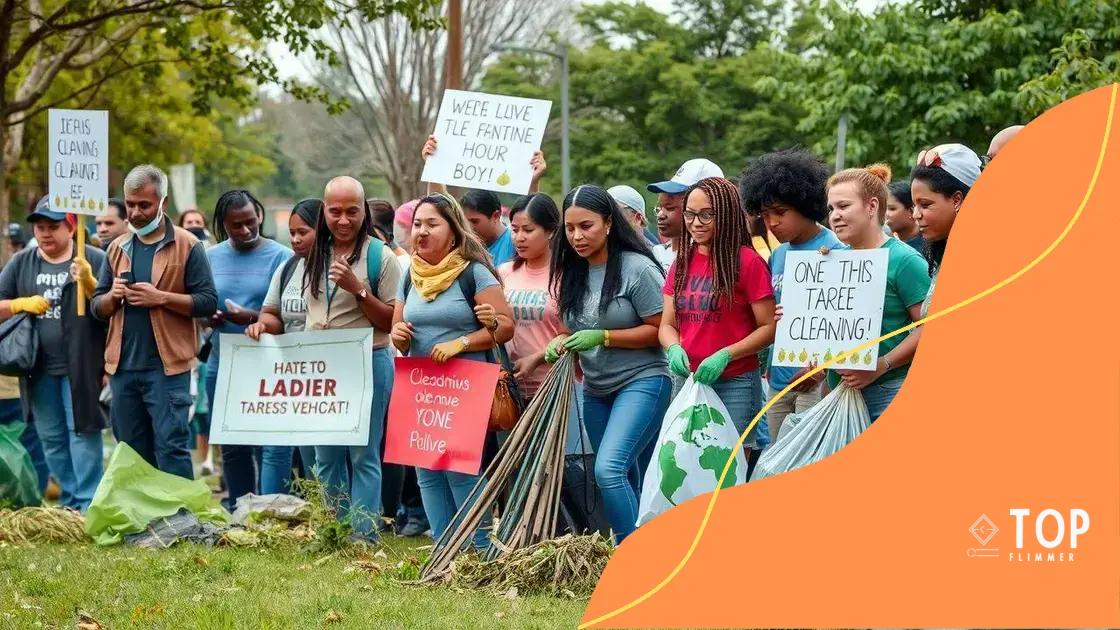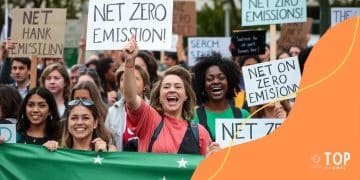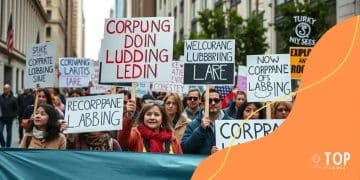Environmental cleanup legislation protests gather momentum

Environmental cleanup legislation protests focus on advocating for stronger policies to address pollution, restore contaminated sites, and involve community engagement in the quest for a healthier environment.
Environmental cleanup legislation protests have taken center stage as communities rally for a healthier planet. Have you noticed more voices calling for action? Let’s dive into the reasons behind this surge.
Understanding environmental cleanup legislation
Understanding environmental cleanup legislation is essential for anyone looking to get involved in environmental activism. These laws play a key role in protecting our natural resources and ensuring safe environments for communities.
There are various types of legislation that focus on environmental cleanup. Each aims to address specific issues regarding pollution, contamination, and restoration. Let’s explore some of the main frameworks that guide these initiatives.
Major Environmental Laws in the U.S.
Several federal and state laws shape environmental cleanup efforts. Here are a few critical ones:
- Comprehensive Environmental Response, Compensation, and Liability Act (CERCLA): This law allows the government to clean up sites contaminated with hazardous substances.
- Resource Conservation and Recovery Act (RCRA): Focused on managing hazardous waste, this law ensures that waste is disposed of properly to protect public health and the environment.
- Clean Water Act (CWA): This legislation regulates discharges of pollutants into the nation’s waters and ensures clean water for all.
These laws create a framework for cleanup efforts, but their effectiveness often relies on community involvement and awareness. Many communities are well-informed about the legislation that affects them, and they actively advocate for better policies.
In addition to federal laws, state regulations also play a vital role in environmental cleanup. Each state has unique statutes that address local environmental issues. Understanding these laws can empower communities to push for necessary changes.
The Importance of Public Awareness
The relationship between legislation and public awareness is crucial. When communities understand their rights and the available resources for cleanup, they can take action effectively. Public participation in the legislative process often leads to stronger policies that prioritize health and safety.
Many groups are working hard to inform the public about environmental conservation and the laws that support it. Workshops, seminars, and social media campaigns are common methods used to spread awareness. These efforts are key in creating a well-informed citizenry that can influence decision-making.
As we explore further, it’s clear that understanding environmental cleanup legislation is just the beginning. There are many aspects to consider when advocating for a cleaner, safer environment.
The rise of protests and community engagement
The rise of protests and community engagement in environmental issues is more prominent than ever. More people are coming together to advocate for changes that drive environmental cleanup legislation forward. This movement is fueled by a growing awareness of climate change, pollution, and the impact these issues have on public health.
Communities are starting to organize rallies and informational sessions to discuss their concerns. Indeed, many individuals have taken it upon themselves to learn about the legislative processes that affect their local environments. By doing so, they empower themselves and their neighbors to demand action.
Increased Visibility of Environmental Issues
Media coverage has played a crucial role in raising awareness. News outlets frequently showcase the efforts of grassroots movements, highlighting their demands for cleaner air and water. This visibility attracts more supporters and amplifies their voices. With hashtags trending on social media platforms, messages about environmental justice reach audiences far and wide.
- Local campaigns: Many neighborhoods are forming coalitions to address specific local problems.
- Educational initiatives: Workshops on environmental issues are common, encouraging community members to engage actively.
- Partnerships with organizations: Collaborations with environmental organizations strengthen the movement’s impact.
As more people join the cause, interesting dynamics emerge. Diverse groups come together, sharing different perspectives and expertise. This collaboration leads to innovative solutions that reflect the needs of the community.
The Power of Collective Action
Collective action is essential in driving change. When a community stands united, their demands for legislation become more difficult to ignore. Governments and corporations often feel the pressure to respond to public outcry.
For instance, local authorities may take notice of a significant increase in protests and public meetings. They might be prompted to reconsider current policies, making strides toward better environmental management. Observing positive change as a result of community efforts builds momentum and encourages more engagement.
In summary, the rise of protests and community engagement not only raises awareness but also fosters a culture of activism. People are realizing that they can influence policy and protect their environments. This grassroots movement signifies a hopeful trend toward greater accountability and sustainable practices in environmental policy.
Key players in environmental activism

Key players in environmental activism are diverse and play crucial roles in advocating for positive change. These individuals and organizations work tirelessly to influence public opinion and government policies regarding environmental cleanup.
Firstly, grassroots organizations are at the forefront. They mobilize communities and bring attention to local environmental issues. These groups often organize events and campaigns, bringing together volunteers who are passionate about making a difference. Every action counts, whether it’s a small clean-up effort or a large rally.
Influential Nonprofits
Many nonprofit organizations also contribute significantly to environmental causes. They often provide valuable resources, research, and support for local initiatives. Examples include:
- The Sierra Club: This organization advocates for clean air and water and promotes renewable energy.
- Greenpeace: Known for its direct action campaigns, Greenpeace focuses on global environmental issues.
- World Wildlife Fund (WWF): WWF works on numerous fronts, including habitat protection and climate action.
These nonprofits often lead large campaigns that attract national attention. Their expertise helps shape legislation and raise public awareness about urgent environmental issues.
Influencers and Community Leaders
In addition to organizations, influential figures and community leaders are vital in the fight for environmental justice. These individuals may include local activists, scientists, and educators who inspire others to take action. Their personal stories and commitments resonate with many, encouraging collective action.
Social media has amplified their voices, allowing them to reach broader audiences. Through platforms like Instagram and Twitter, they share information, highlight initiatives, and call for solidarity in tackling environmental challenges.
With the rise of influential young activists, such as Greta Thunberg, the movement has gained momentum. Young people are becoming more engaged, leading protests, and demanding change. Their involvement signals a shift in priorities, focusing on sustainability for future generations.
Recognizing the key players in environmental activism helps us understand the collective effort required to address pressing ecological concerns. Awareness of these individuals and organizations inspires others to join the movement.
Legal frameworks surrounding cleanup initiatives
Understanding the legal frameworks surrounding cleanup initiatives is crucial for effective environmental activism. These laws and regulations establish guidelines for how cleanup efforts should be conducted and who is responsible for different actions.
The main frameworks include federal legislation, state laws, and local ordinances. At the federal level, laws like the Comprehensive Environmental Response, Compensation, and Liability Act (CERCLA) set important standards for environmental cleanup.
Key Federal Laws
Several key federal laws shape the cleanup process:
- Superfund program: Created under CERCLA, this program is designed to clean up sites contaminated with hazardous substances.
- Resource Conservation and Recovery Act (RCRA): This act governs the disposal of hazardous waste and encourages waste reduction.
- Clean Water Act (CWA): Regulates discharges of pollutants into the waters of the United States, ensuring water quality.
These laws establish liability for pollution, outlining who is responsible for cleanup costs. By holding polluters accountable, the law incentivizes organizations to maintain environmental integrity.
State and Local Regulations
In addition to federal laws, every state has its own regulations that complement national efforts. These state laws address specific local environmental challenges and include guidelines for remediation actions.
Local governments often implement ordinances that directly impact the community. Examples include requirements for environmental assessments before construction and protocols for waste disposal. These local regulations empower communities to protect their environments at a grassroots level.
Compliance with established regulations ensures that cleanup initiatives follow best practices, ultimately leading to safer and healthier environments. Stakeholders, including government agencies, businesses, and local communities, must work together to ensure adherence.
Understanding the legal aspects surrounding cleanup initiatives equips advocates with the tools they need to engage in informed activism. This knowledge can also help communities push for stronger regulations that better protect them from environmental hazards.
Success stories from recent legislative efforts
Success stories from recent legislative efforts in environmental cleanup illustrate the positive impact that effective policies can have on communities. These stories often highlight how collaborative efforts can lead to significant improvements in both environmental quality and public health.
One notable example is the passage of the Infrastructure Investment and Jobs Act, which allocates substantial funding for cleaning up contaminated sites across the country. This law showcases how federal support can empower local communities to address pressing environmental issues.
Case Study: Chesapeake Bay Restoration
The Chesapeake Bay is a prime success story in concerted legislative efforts. The Chesapeake Bay Program, established through a series of agreements and policies, has led to improved water quality and habitat restoration. Thanks to initiatives funded by state and federal sources, local governments have implemented effective practices to reduce pollution.
- Pollution reduction: New regulations on wastewater treatment have significantly decreased nutrient runoff.
- Habitat restoration: Efforts to restore wetlands and reduce sediment erosion have enhanced biodiversity.
- Community engagement: Programs promoting local stewardship have fostered active community participation in conservation efforts.
These combined actions demonstrate how effective legislation can lead to meaningful environmental restoration, benefiting both the ecosystem and local communities.
California’s SB 100: A Milestone in Clean Energy
Another success story is California’s Senate Bill 100, which sets a bold goal for the state to transition to 100% clean energy by 2045. This ambitious legislation has spearheaded a series of initiatives aimed at reducing greenhouse gas emissions and investing in renewable energy sources.
As a result, California has seen an increase in job creation in the clean energy sector, with thousands of new positions dedicated to developing solar and wind energy technologies. This legislative effort exemplifies how proactive policies can drive economic growth while tackling climate change.
Highlighting these success stories showcases the potential for legislative efforts to foster positive change in environmental practices. These examples encourage other states and communities to pursue similar initiatives, ultimately contributing to a healthier planet.
In conclusion, the journey of environmental cleanup legislation and activism shows us that positive change is possible. Through collective efforts, communities have successfully influenced policies to protect their environments. Success stories like the Chesapeake Bay Restoration and California’s SB 100 inspire us to continue advocating for sustainable practices. As we move forward, staying informed and engaged will empower individuals and communities to make a significant impact on our planet’s health.
FAQ – Frequently Asked Questions about Environmental Cleanup Legislation
What is environmental cleanup legislation?
Environmental cleanup legislation refers to laws and regulations aimed at addressing pollution and promoting the cleanup of contaminated sites to protect public health and the environment.
How can local communities influence environmental laws?
Local communities can influence environmental laws by advocating for policy changes, participating in public meetings, and collaborating with grassroots organizations to raise awareness about local issues.
What are some successful examples of environmental cleanup initiatives?
Successful examples include the Chesapeake Bay Restoration Program and California’s SB 100, which aim for improved water quality and 100% clean energy by 2045, respectively.
Why is public awareness important in environmental activism?
Public awareness is crucial because it encourages community involvement, informs individuals about their rights, and holds policymakers accountable for creating effective environmental legislation.






